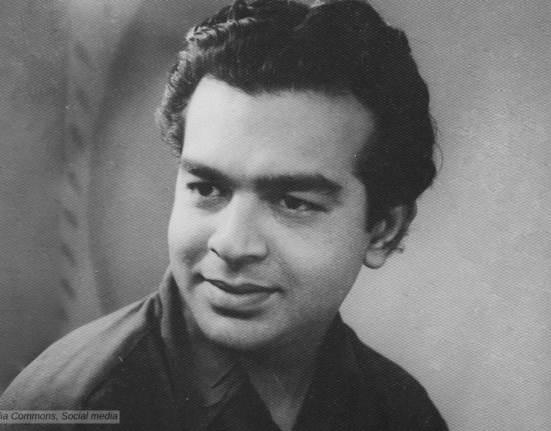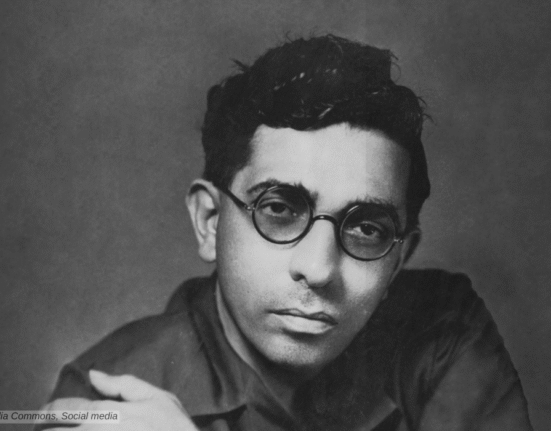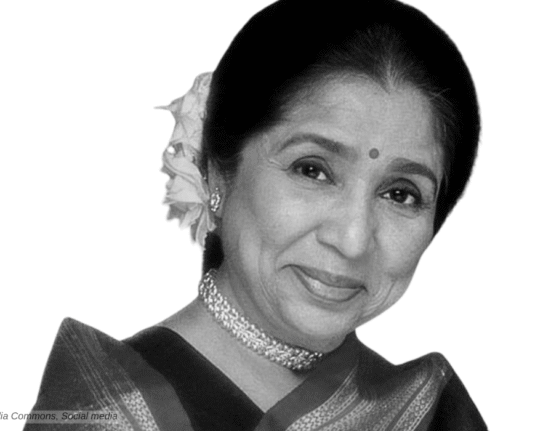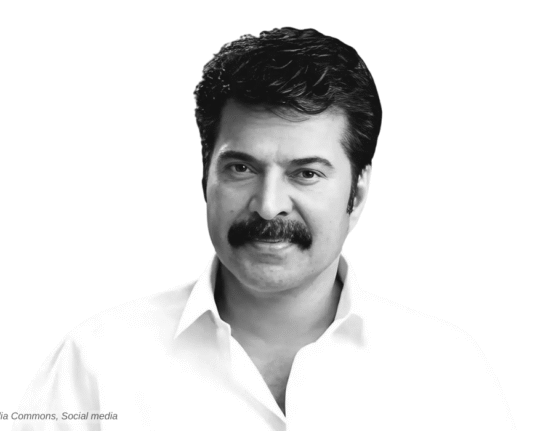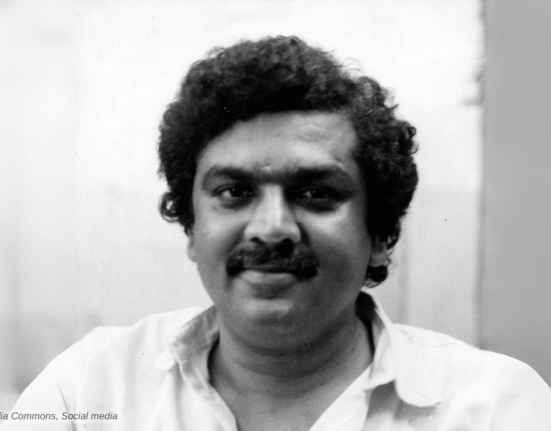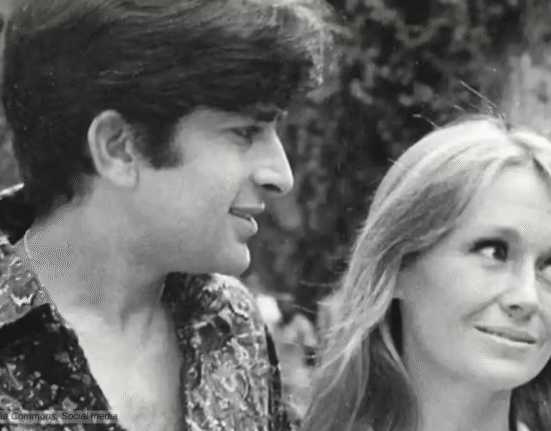Best remembered for his piercing grey eyes and commanding voice, which could chill you to the bone, Chandra Mohan became one of the most towering figures of Hindi cinema in the 1930s and 1940s. Known for his larger-than-life character, dramatic style of acting, and epic dialogue delivery, he starred in many iconic films like “Pukar (1939), “Roti” (1942), “Humayun” (1945), Shaheed (1948), and many more.
Early Life and Career
Chandra Mohan was born on July 24, 1906, as “Chandra Mohan Wattal” in Narsinghpur, Madhya Pradesh, into a Kashmiri Pandit family from Allahabad. His father, Pandit Jagannath Sahai Wattal, a cousin of Sir Tej Bahadur Sapru, moved to Gwalior around 1900, where he got employment with Maharaja Madhav Rao Scindia. His mother’s family was from Narsingpur, where he was brought up by his maternal grandmother after his mother’s early death.
Chandra Mohan’s cinematic journey kicked off with a bang in 1934, thanks to a chance meeting with destiny—or rather, with V. Shantaram. The director spotted something in this young man from Madhya Pradesh and cast him as Rajguru in “Amrit Manthan“, the first film from the freshly minted Prabhat Film Company. Shot in both Hindi and Marathi. It was reported that V. Shantaram was so impressed by his looks and personality that he said, “His looks are regal. I want to have him at any price.”
Breathrough

The movie opens with a close-up of his haunting grey eyes, a bold choice that hooked audiences instantly. Playing a scheming priest opposite Durga Khote, he didn’t just act—he owned the screen, setting the tone for a career built on it, and his large expressive grey eyes became his trademark.
In 1935, he was cast in “Dharmatma” with Bal Gandharva and Ratanprabha, followed by “Amar Jyoti“ in 1936 with Durga Khote and Shanta Apte. Amar Jyoti earned him a pan-India fan following and made him a box office phenomenon. He left the Prabhat studio in 1938 after a disagreement with V. Shantaram.
He worked in Sohrab Modi’s “Pukar” in 1939, which became the highest-grossing film of the time. The film also has Sohrab Modi, Naseem Banu, and Sardar Akhtar in important roles. In Mehboob Khan’s “Roti (1942),” he starred with Sheikh Mukhtar, and Sitara Devi. The film also starred Ghazal Doyen “Begum Akhtar”, then Akhtari Bai Faizabadi. In the film he played the role of Seth Laxmidas, a greedy and ruthless capitalist.
Chandra Mohan The Star
His other successes include Parshwanath Yeshwant Altekar’s “Geeta (1940)” with Durga Khote. In 1943 he starred in Mehboob Khan’s Taqdeer, with Moti Lal, Noor Mohammad Charlie, Jilloobai and a young Nargis. In the film He played a judge who lost his daughter in Kumbh and find a lost boy whom he adopted. His daughter on the otherhand find by boy’s father played by Charlie.
He played the role of King Dushyant in V. Shantaram’s “Shakuntala (1943)” with Jayashree, Kumar Ganesh, Jayashree, V Shantaram, and Zohra Sehgal. He also acted in Shaukat Hussain Rizvi’s “Naukar (1943)” with Noor Jehan, Dwarka Khosla’s “Raunaq (1944)” with Motilal, Swaran Lata, Chandraprabha and Noor Mohammed Charlie, Ram Daryani’s “Panna Dai (1945)” with Durga Khote, Kidar Sharma’s “Mumtaz Mahal (1945)” with Khursheed Bano, Madhubala and Kajjan Bai, Roop K. Shorey’s “Shalimar (1946)” with Begum Para, and many more.
In Ramesh Saigal’s 1948 film Shaheed, Chandra Mohan starred as Rai Bahadur Dwarka Nath, father to Ram, played by Dilip Kumar. Initially supporting the British government, his character later sides with the freedom struggle. This marked one of Mohan’s final appearances. His last movie was “Rambaan (1948)“, a religious film in which he portrayed the demon emperor Ravana.


Legacy Chandra Mohan
In 1945, K. Asif had originally signed Chandramohan for “Mughal-e-Azam” to play the role of Akbar, with Nargis as Anarkali, Veena as Bahar, and another light-eyed Kashmiri, D. K. Sapru, as Salim. However, due to the partition of the country in 1947, the producer of the movie, Hakim Shiraz Ali, decided to go to Pakistan. The movie remained unfinished. Later on, when the determined K. Asif revived this project in 1951–52, Chandra Mohan was no more.
An interesting piece of trivia is that although Sapru and Chandra Mohan were not part of Mughal-e-Azam, Sapru played the role of Salim in the 1955 movie “Adl-e-Jahangir,” while Chandra Mohan played the role of Salim in “Pukar (1939).”
Chander Mohan was a close friend of Ulhaas, K N Singh, KL Saigal, Prithvi Raj Kapoor, Rajan Haksar, and Moti Lal. He was fond of buying racehorses and betting, and he drank the best-quality Scottish whisky. His horse racing friends included Maharaja Harisingh of Kashmir and the Maharaja Jeewajirao Scindia of Gwalior.
The stardom and influence of Chandramohan could be understood by following the story. Once, when Chandramohan was late for a shoot, the assistant director rushed to him. Chandramohan handed him his coat, saying, “Tell the director that even Chandramohan’s coat can act until he arrives.”
Chandra Mohan’s life was as dramatic as his roles. In the mid-‘40s, he was into gambling big time. A love for cards and liquor drained his earnings, a reckless streak that clashed with his on-screen discipline. That vice hit hard in 1947 when a heart attack struck at 41, a warning he ignored. His biggest near miss? “Mughal-e-Azam”, where he was cast as Akbar by K. Asif. He’d shot a few reels by 1948 when illness sidelined him. His death in ‘49 scrapped that footage, a loss that still stings film buffs.
By the late ‘40s, Chandra Mohan’s spark was dimming. That 1947 heart attack slowed him, but he pushed on, filming “Rambaan” and “Shaheed“. His vices—gambling and drinking—caught up with him, eroding his health and fortune. Although Chandramohan remained unmarried, he spent lakhs of rupees entertaining friends, throwing liquor parties, gambling, and horse racing.
On April 2, 1949, at 42, he suffered a final heart attack in his home at Bilkha House. Found lifeless among empty bottles, he left penniless, a stark end for a man who’d once commanded screens. Cremated quietly in Bombay, his death barely rippled the industry he’d helped build—yet his work endured.
Chandra Mohan on IMDB




